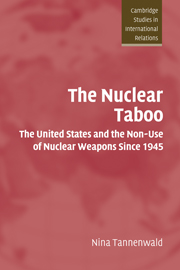Book contents
- Frontmatter
- Contents
- Preface
- List of abbreviations
- 1 Introduction: the tradition of nuclear non-use
- 2 Explaining non-use
- 3 Hiroshima and the origins of the nuclear taboo
- 4 The Korean War: the emerging taboo
- 5 The rise of the nuclear taboo, 1953–1960
- 6 Nuclear weapons and the Vietnam War
- 7 Institutionalizing the taboo, 1960–1989
- 8 The 1991 Gulf War
- 9 The taboo in the post-Cold War world
- 10 Conclusion: the prospects for the nuclear taboo
- Select bibliography
- Index
- CAMBRIDGE STUDIES IN INTERNATIONAL RELATIONS
Preface
Published online by Cambridge University Press: 22 September 2009
- Frontmatter
- Contents
- Preface
- List of abbreviations
- 1 Introduction: the tradition of nuclear non-use
- 2 Explaining non-use
- 3 Hiroshima and the origins of the nuclear taboo
- 4 The Korean War: the emerging taboo
- 5 The rise of the nuclear taboo, 1953–1960
- 6 Nuclear weapons and the Vietnam War
- 7 Institutionalizing the taboo, 1960–1989
- 8 The 1991 Gulf War
- 9 The taboo in the post-Cold War world
- 10 Conclusion: the prospects for the nuclear taboo
- Select bibliography
- Index
- CAMBRIDGE STUDIES IN INTERNATIONAL RELATIONS
Summary
This book had its origins in what seemed to me a disconnect between how ordinary people, including many policymakers, have viewed nuclear weapons and how academic deterrence theory has approached the analysis of such weapons. In college I had been involved in the nuclear freeze movement, aimed at halting the US–Soviet nuclear arms race. Most people in this movement shared a deep sense of revulsion at the tremendous destructive power of nuclear weapons, and held their use to be immoral and irrational.
Later, in graduate school, I studied academic deterrence theory. It focused on the cold, hard calculus of making credible threats of massive destruction. These game-theoretic analyses, I found, had little to say about issues of revulsion and morality. Further, when I studied how we managed to avoid nuclear war during the Cold War, it increasingly appeared to me that deterrence was not the whole story. Deterrence could not explain, for example, why nuclear weapons had not been used when the other side did not possess such weapons. I found it hard to avoid a sense that a powerful revulsion associated with nuclear weapons had played a role in inhibiting their use.
If indeed a nuclear taboo exists, how do we know, and how exactly did this taboo emerge? How has it influenced leaders? I decided to find out. This book is the result.
- Type
- Chapter
- Information
- The Nuclear TabooThe United States and the Non-Use of Nuclear Weapons Since 1945, pp. ix - xiiPublisher: Cambridge University PressPrint publication year: 2007

